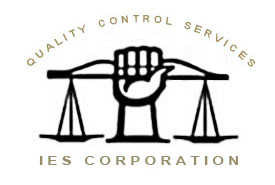QCS / IES Corporation

Evaluating Laboratory Balance Performance:
The purpose of this article is to help laboratory balance users evaluate their equipment to determine whether it requires repair, on-site adjustment, or a change in how the equipment is used.:
Functional problems fall into either of two categories:
1) Problems that are a matter of adjustment and can be corrected on-site by field service technicians.:
2) Problems caused by defective components within the equipment and which indicate that the instrument needs to be repaired. QCS / IES Corporation is a repair facility specializing in this type of repair.
Other problems are the result of environmental factors and/or the way the instrument is operated. These can be corrected by the laboratory balance user. Here are tests and indicators that you can use to evaluate your laboratory balances:
DRIFT:Drift refers to weight readings that do not stabilize, or unstable readings with no weight applied. All analytical balances show some uncertainty. Some do so more than others. The clearest indication of malfunction is a change in the amount of instability.
Two environmental factors affect the instrument’s stability dramatically--temperature and static electricity. Temperature control is imperative. This includes both control of the room temperature and maintaining the internal temperature of the instrument. For best stability, maintain the room temperature within two degrees constantly (day and night). Leave the instrument plugged in and turned ON. Static electricity will cause erratic readings. Instruments should be operated on a static dissipating surface (anti-static mat). Operators should stand on anti-static floor covering. Avoid the use of plastic containers for items being weighed. Never replace broken glass doors on instruments with plastic ones. Maintain humidity at 65% or more. Eliminate sources of floor vibration and air currents. On analytical balances with glass doors, be sure the doors close fully.
Instruments that have served satisfactorily but suddenly become unstable are likely to need repair. Contact QCS / IES for assistance with these.
REPEATABILITY:
Repeatability refers to an instrument’s ability to consistently deliver the same weight reading for a given object, and to return to a zero reading after each weighing cycle. Test this by repeatedly weighing the same object. The best test object is a weight intended for that purpose. It should match the weighing capacity of the instrument. (Do not test a 200gram capacity instrument with a test weight less than 100grams.) When a test weight is not available, an alternative object that is solid, non-porous, dirt free, non-magnetic, and non-static retaining can be used. Poor repeatability is often caused by damage to the weighing cell. Contact QCS / IES if you are having this problem.
INOPERATIVE INSTRUMENTS:
Inoperative instruments are those that are either damaged, or clearly not producing weighing results. Examples are bent, broken, or damaged parts or numerical readouts that are blank, frozen, or nonsensical. Some instruments are damaged by mishandling or by contamination from water or chemicals. These problems clearly require component levelrepair. Contact QCS / IES for repair of these problems.
CORNERLOAD:
Cornerload refers to the ability of an instrument to deliver the same weight reading for a given object anywhere on the weighing pan. (Of course, an instrument that does not perform acceptably with regard to drift and repeatability cannot possibly deliver acceptable cornerload performance.) Test this characteristic using the same test weight that was used to test repeatability. Position the object at various locations on the weighing pan. The reading should be the same, within a few digits, at all positions. Cornerload errors are normally adjusted by a field service technician during on-site service.
LINEARITY:
Linearity refers to the quality of delivering identical sensitivity throughout the weighing capacity. Test this characteristic by weighing two stable objects separately, each of approximately one half the weighing capacity. The sum of the two readings should equal the reading obtained when both objects are weighed together. Linearity is adjusted during on-site service.
CALIBRATION:
Calibration refers to the actual accuracy of an instrument. To test this yourself you need a test weight with approximately the same accuracy as your instrument. Consider buying more than one, each a fraction of the capacity, in order to test linearity. Contact QCS Metrology Department for questions about weights. Many instruments contain internal calibration weights that are quite accurate, and can be used by the operator routinely. Check your operator’s guide. Field service technicians have very accurate test weights that can be used to verify calibration. Calibration is normally adjusted during on-site service.
SERVICE FOR LABORATORY BALANCES:
On-Site Service by field service technicians.
On-site service is available throughout the US from both factory representatives and from independent providers, QCS covers most of the NorthWest. Consult the instrument manufacturer, or look in the Yellow Pages under headings such as Scales, Laboratory Equipment & Supplies, or Scientific Instruments & Supplies. Charges vary with travel requirements and number of instruments serviced.

Shop Tip:
Evaluation Process:
The process of evaluation has a simple order, meaning some tests may be irrelevant if others fail.
- Repeatability
- Cornerload
- Linearity
- Sensitivity
Why would we be trying to calibrate a unit ( sensitivity ) if cornerload is out of specification ? or if repeatability is unacceptible ?
An understanding of how each test effect others is the key to efficency.